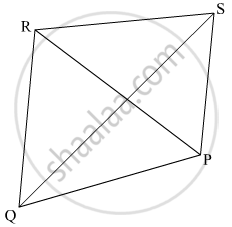Advertisements
Advertisements
Question
Prove that in a quadrilateral the sum of all the sides is greater than the sum of its diagonals.
Solution
We have to prove that the sum of four sides of quadrilateral is greater than sum of diagonal.

Since the sum of two sides of triangle is greater than third side.
In ΔPQR we have
PQ + QR > PR ..........(1)
In ΔRSPwe have
RS + SP >PR ..........(2)
In ΔPQS we have
PQ + SP > QS ........(3)
In ΔQRSwe have
QR + RS > QS .........(4)
Adding (1) & (2) & (3) and (4) we get
2(PQ + QR + RS + SQ ) >2 (PR + QS)
Hence (PQ + QR + RS + SQ > PR + QS)Proved.
APPEARS IN
RELATED QUESTIONS
ABC is a right angled triangle in which ∠A = 90° and AB = AC. Find ∠B and ∠C.
AD is an altitude of an isosceles triangles ABC in which AB = AC. Show that
- AD bisects BC
- AD bisects ∠A
BE and CF are two equal altitudes of a triangle ABC. Using RHS congruence rule, prove that the triangle ABC is isosceles.
ABC is an isosceles triangle with AB = AC. Drawn AP ⊥ BC to show that ∠B = ∠C.
ABC and DBC are two triangles on the same base BC such that A and D lie on the opposite sides of BC, AB = AC and DB = DC. Show that AD is the perpendicular bisector of BC.
ABC is an isosceles triangle in which AC = BC. AD and BE are respectively two altitudes to sides BC and AC. Prove that AE = BD.
Prove that sum of any two sides of a triangle is greater than twice the median with respect to the third side.
In a right triangle, prove that the line-segment joining the mid-point of the hypotenuse to the opposite vertex is half the hypotenuse.
Two lines l and m intersect at the point O and P is a point on a line n passing through the point O such that P is equidistant from l and m. Prove that n is the bisector of the angle formed by l and m.
ABCD is quadrilateral such that AB = AD and CB = CD. Prove that AC is the perpendicular bisector of BD.
